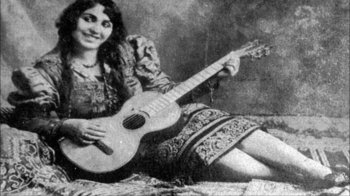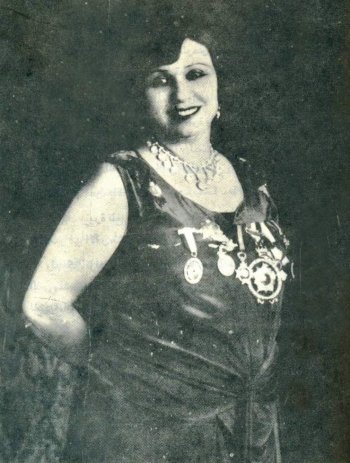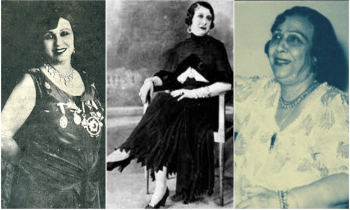Munira Mahdia, or Sultana Al-Tarab, whose real name is Zakia Hassan Mansour.
She was born on May 16, 1885, in the village of Mahdia in the Eastern Governorate, and she was giving concerts in the city of Zagazig, where a café owner saw her and persuaded her to travel to Cairo because of her beautiful appearance and voice.
her successes
In the summer of 1915, Munira al-Mahdiyya stood on stage with the “Aziz Eid” troupe and played the role of “Hassan” in a novel by Sheikh Salama Hegazy, becoming the first Egyptian woman to stand on the stage, which increased the demand for the play, and she traveled on an artistic tour that lasted for 3 years, and the band toured in : Lebanon, Iraq, Syria, Turkey, Iran, Palestine, Libya, Tunisia and Morocco.
In Turkey, Munira al-Mahdiya sang in front of Mustafa Kemal Ataturk, who was one of the pioneers of her theater in Cairo, and when the curtain came down, he shouted that Munira should not come down and raise the curtain again so that Munira would continue to sing all night while Atatürk was in a state of ecstasy and amazement.
In Syria, a tobacco company decided to print a picture of Munira on cigarette packs and they called it “Dukhan Munira”.
In Iraq, the poet Marouf Al-Rusafi singled it out with a poem that says: Come to the singing from which Munira came with wonder. Isn’t Munira in our time the master of the art of Arab singing?
Munira Al-Mahdia is the first Egyptian singer to record records for her songs, and she is also an Egyptian woman who works as a director, and she directed two plays, “Carmen” and “Taise”.
Munira al-Mahdiyya stood in front of the cinema camera only once, as she starred in the movie “Al-Ghandoura” in 1935 to be her only film, and it was directed by the Italian Volpi, and Munira had tried to return to art through it, but she could not keep pace with the time, melodies and the accelerating rhythm of music, The life of Munira, who received the title of the first Azbakeya singer, ended.
Her personal life and marriage
 Munira al-Mahdiyya married four times in her life. Her first marriage was to Mahmoud Jabr in 1905, to become her business manager. This marriage lasted for a long time until a dispute arose between them, which ended in divorce. Then she married Hassan Nadim, followed by Hassan Kamal, and then his brother Ibrahim Kamal after his death. She has only one daughter, Naamat, from four marriages. In one of her statements, Munira al-Mahdiyya said: “Our Lord has given me a voice. They say that it is like it, except every 100 years, and Sheikh Salama Hijazi described my voice as a white voice.”
Munira al-Mahdiyya married four times in her life. Her first marriage was to Mahmoud Jabr in 1905, to become her business manager. This marriage lasted for a long time until a dispute arose between them, which ended in divorce. Then she married Hassan Nadim, followed by Hassan Kamal, and then his brother Ibrahim Kamal after his death. She has only one daughter, Naamat, from four marriages. In one of her statements, Munira al-Mahdiyya said: “Our Lord has given me a voice. They say that it is like it, except every 100 years, and Sheikh Salama Hijazi described my voice as a white voice.”
Its participation in political life and its role in the liberation of women
 Munira al-Mahdiyya had a great role in the liberation of women, as she led a national movement through her theater and lyrical art, and established a café in the Azbakeya neighborhood, which she called “Nozha al-Nufus.” Senior politicians and writers in Egypt, the Levant, and Sudan used to meet in it and at her home. Its theater at that time was called “The Freedom Theatre”.
Munira al-Mahdiyya had a great role in the liberation of women, as she led a national movement through her theater and lyrical art, and established a café in the Azbakeya neighborhood, which she called “Nozha al-Nufus.” Senior politicians and writers in Egypt, the Levant, and Sudan used to meet in it and at her home. Its theater at that time was called “The Freedom Theatre”.
On the political side, Munira played a national role through her plays and songs, especially during the 1919 revolution, so that the British occupation of Egypt at that time was unable to close her cafe, due to the strength of her personality, her influence on the public and her relationship with politicians.
At a time when it was forbidden to utter the name of the Egyptian leader, Saad Zaghloul, and he imprisoned anyone who mentioned it, Munira sang to Saad with a trick without uttering his name, saying: “The pigeon shawl came to the bathroom, from happy Egypt when Sudan, Zaghloul and my heart went to him, he was shocked when I need him”.
first actress
on the Although she was playing the role of a man, Munira Al-Mahdiya separated from the Aziz Eid band, and formed a special band for her. She presented the most famous works of Sheikh Salama Hegazy, and also worked with the most famous analysts and poets, and she was one of the discoverers of the talent of the Egyptian musician. the lateMuhammad Abd-alwahab.
Although she was playing the role of a man, Munira Al-Mahdiya separated from the Aziz Eid band, and formed a special band for her. She presented the most famous works of Sheikh Salama Hegazy, and also worked with the most famous analysts and poets, and she was one of the discoverers of the talent of the Egyptian musician. the lateMuhammad Abd-alwahab.
In her lifetime, Munira al-Mahdiya received many awards, most notably: the Order of Merit of the first degree in 1960, the excellent prize in theatrical singing competition in 1962, the Medal of Science and Arts of the first class in 1961, and her name was also included in the Golden Book of the King of Italy and she was awarded a medal So.
Munira Al-Art retired with the beginning of the entry of the late Egyptian artist Umm KulthumArt, and the support of singing giants for her, as well as her introduction of a new style, and in 1948, she decided to return after twenty years of retirement, but she did not receive the acceptance that she was waiting for.
This period witnessed a sharp conflict between Munira al-Mahdiyya and Umm Kulthum, who had imposed new conditions on the artistic scene that Munira could not keep up with, so she quit art and devote herself to her hobby, which is raising pets.
In words that the audience considered a clear challenge to the planet of the East, Munira Al-Mahdiyya said: “No, this is a priest. Umm Kulthum, where Umm Kulthum had conducted an interview in which she said that she is in harmony with her voice, and sometimes cries because of it.
Munira al-Mahdiyya died on March 11, 1965 at the age of eighty, after a busy artistic life that spanned more than fifty years.
–


